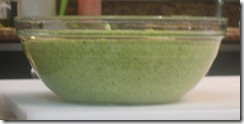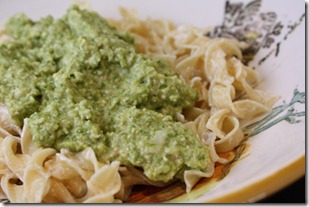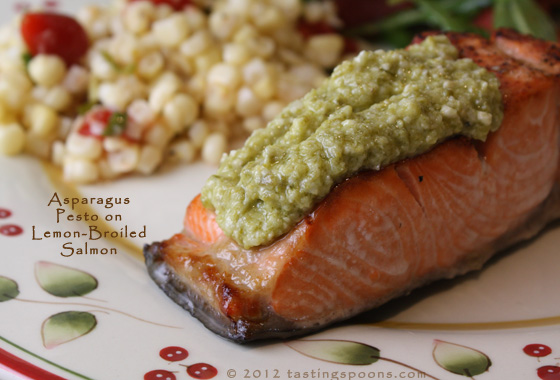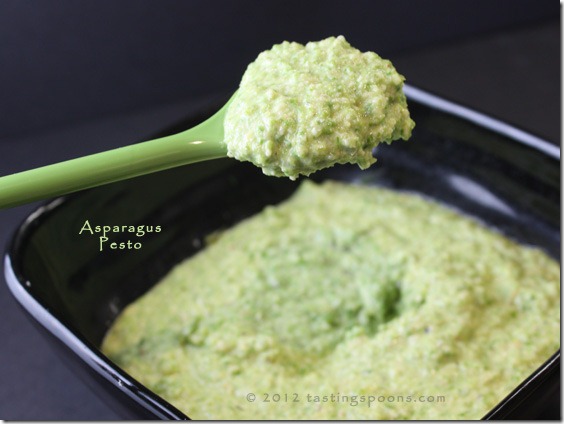If you had told me a month or so ago that I’d be CRAZY about asparagus pesto, I’d probably have thought you were brain-addled. Asparagus – well, I love it – but as pesto? It’s kind of hard to get your mind around that combination. You’ve gotta try it, though!
The oldest mention I found online about this pesto is from 1999, a Gourmet magazine issue. It’s not quite this same recipe, but very similar. I mean, pesto is pesto, meaning it’s a type of condiment – the  main ingredient of course, be it basil, or cilantro, or Italian parsley – and in this case it’s asparagus. And it gets mixed with pine nuts (also a usual staple in pesto, although I’ve had it with walnuts too), garlic, olive oil and Parmigiano cheese. All yummy ingredients in my mind! But to put them together amazes me. Who THINKS these things, I want to know? More creative cooks than I, certainly. This recipe came from a cooking class with Phillis Carey, who keeps managing to find new and different ways to cook. It’s why I keep going back to her classes – she keeps me interested. And learning. I wouldn’t go to cooking classes if I didn’t learn something!
main ingredient of course, be it basil, or cilantro, or Italian parsley – and in this case it’s asparagus. And it gets mixed with pine nuts (also a usual staple in pesto, although I’ve had it with walnuts too), garlic, olive oil and Parmigiano cheese. All yummy ingredients in my mind! But to put them together amazes me. Who THINKS these things, I want to know? More creative cooks than I, certainly. This recipe came from a cooking class with Phillis Carey, who keeps managing to find new and different ways to cook. It’s why I keep going back to her classes – she keeps me interested. And learning. I wouldn’t go to cooking classes if I didn’t learn something!
 In the class she offhandedly mentioned that the sauce is good on fish or shrimp, and to serve it with coconut rice or buttered orzo. Or, to make it a pasta main dish – as a pasta sauce with fish or shrimp (or salmon). All those things sounded good. She prepared it with salmon and napped the sauce on top of it. So I’ve made it two ways so far – over pasta as a side dish, and with salmon. Both fantastic. Both worth making. But if you have left overs (as I did) then you’ll know you can make it other ways too. I think it could also be served as an appetizer with toasted bread.
In the class she offhandedly mentioned that the sauce is good on fish or shrimp, and to serve it with coconut rice or buttered orzo. Or, to make it a pasta main dish – as a pasta sauce with fish or shrimp (or salmon). All those things sounded good. She prepared it with salmon and napped the sauce on top of it. So I’ve made it two ways so far – over pasta as a side dish, and with salmon. Both fantastic. Both worth making. But if you have left overs (as I did) then you’ll know you can make it other ways too. I think it could also be served as an appetizer with toasted bread.
One of the questions you might have – does it still taste like asparagus? Yes it does. And I wouldn’t have made it myself if you’d lose the asparagus flavor – why do that when asparagus has such a unique taste. But yes, the asparagus flavor is quite prominent. You also taste the Parmigiano. You can’t pick out the pine nut flavor, but am certain it wouldn’t be anywhere near as good without them.
My favorite of the two was with the salmon, and I’m including the full recipe for that below. Using a unique broil/bake method to cook the salmon. It’s so easy to do, and very, very tasty. Make the asparagus pesto several hours ahead (or even the day before) and cook the salmon at the last minute. The salmon is marinated for 20 minutes, then it’s baked – actually on the broil setting – but you put the pan way down low in the oven – so the salmon browns beautifully and cooks through without having to turn it over (such a nuisance, especially if there is skin attached). The salmon is so moist and succulent this way. Do put it on a heated plate, though, then spoon the pesto over the top. Don’t cover it – you want to see the beautiful browned salmon.
What I liked: every single solitary thing about it. Taste, texture, versatility and with salmon? Delish.
What I didn’t like: absolutely nothing at all. Very worth making.
MasterCook 5+ import file – right click to save file, run MC, then File|Import
Asparagus Pesto on Broiled Lemon Salmon Filets
Recipe By: Phillis Carey
Serving Size: 6
Serving Ideas: This can be a meal-in-one if you boil a pound of orzo to serve under this. Drain, pour the orzo out onto a very hot platter, place the salmon fillets on top, then pour the asparagus pesto over the top. Don’t cover the salmon fillets with the sauce – it can be on some of the salmon, but not all.
NOTES: Make sure the pesto is almost pourable – if it’s too chunky it won’t mix with rice or pasta, so do add some of the asparagus cooking liquid to thin the sauce if necessary.
1 pound asparagus — trimmed and cut into 2-inch segments
1 clove garlic — or more to taste
1/4 cup pine nuts
1/4 cup olive oil — or more as desired
3/4 cup Parmigiano-Reggiano cheese — freshly grated (maybe a tad more)
Freshly ground black pepper
Juice of 1/2 lemon — or to taste
SALMON:
1/4 cup fresh lemon juice
1/4 cup olive oil
1 clove garlic — minced
1 pinch red pepper flakes
36 ounces salmon fillets — (cut into 6 servings)
1. PESTO: Bring a large pot of water to a boil and salt it. Add the asparagus and cook until fully tender but not mushy, 8 to 10 minutes. Drain well, RESERVING some of the cooking liquid, and let the asparagus cool slightly.
2. Transfer the asparagus to a food processor and add the garlic, pine nuts, 2 tablespoons of the oil, Parmesan, a pinch of salt and a couple of tablespoons of the cooking liquid. Process the mixture, stopping to scrape down the sides of the container if necessary, and gradually add the remaining oil and a bit more of the reserved cooking liquid to moisten if necessary. Add the lemon juice and season with salt and pepper to taste, pulse one last time, and serve over pasta, fish or chicken (or cover and refrigerate for up to a day).
3. SALMON: In a plastic bag add lemon juice, olive oil, garlic and red pepper flakes. Squish bag gently to mix, then add salmon filets. Seal bag and refrigerate for 20 minutes only.
4. Drain salmon then place filets on a rimmed baking sheet lined with parchment paper (latter not required, but makes for easier cleanup). Preheat broiler, but set rack 8-10 inches below the broiling element (no closer). Broil salmon until nicely browned. You do not have to turn the salmon – cooking this way eliminates that step.
5. Remove salmon, plate it and nap about 1/4 cup of asparagus pesto across the piece (not lengthwise, but across).
Per Serving (assumes you’ll eat all the pesto – you might not do so): 448 Calories; 30g Fat (60.1% calories from fat); 40g Protein; 4g Carbohydrate; 1g Dietary Fiber; 96mg Cholesterol; 301mg Sodium.







Kalyn
said on July 4th, 2012:
I am completely intrigued by this!
I know. It’s just SO different. But it’s fantastic, I guarantee. . . carolyn t
Tillie
said on July 8th, 2012:
Thanks so much!! I love your website and blog!
You’re welcome and thanks for the compliments . . . carolyn T